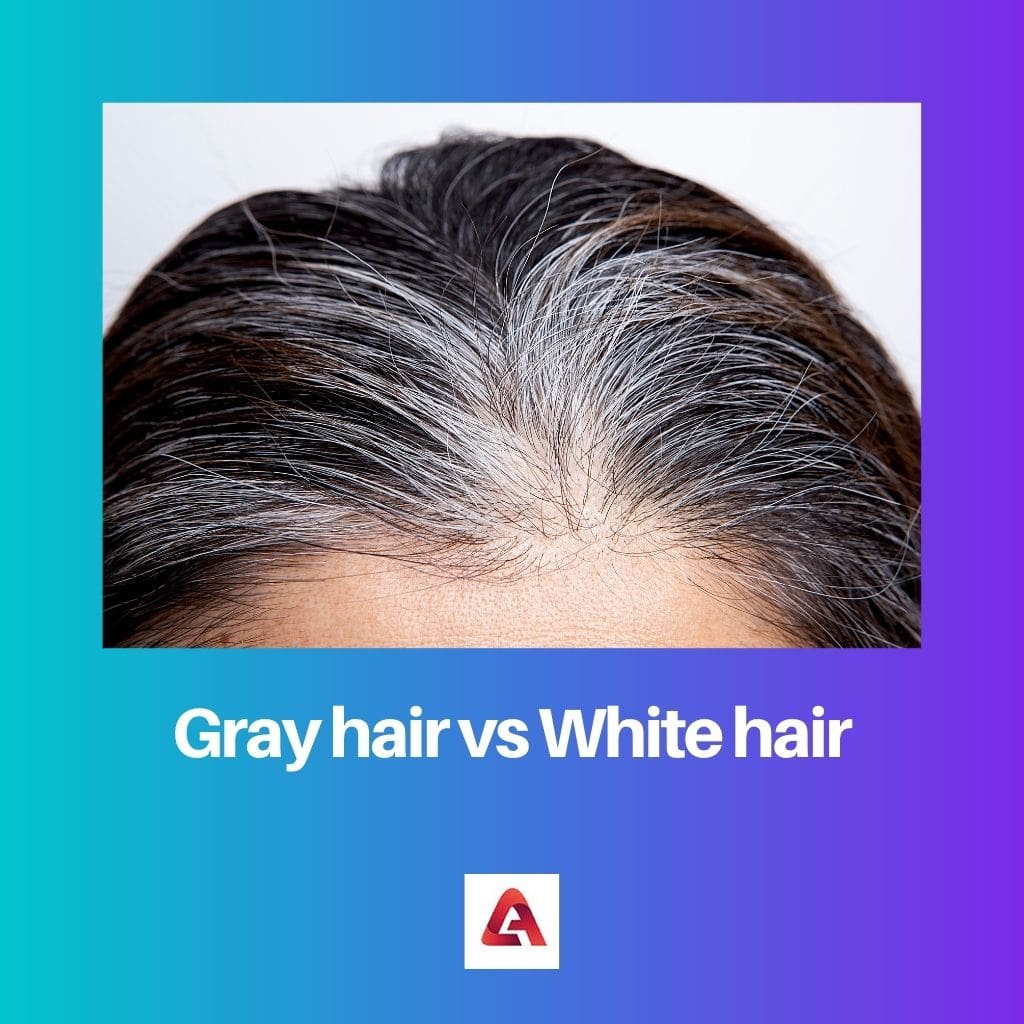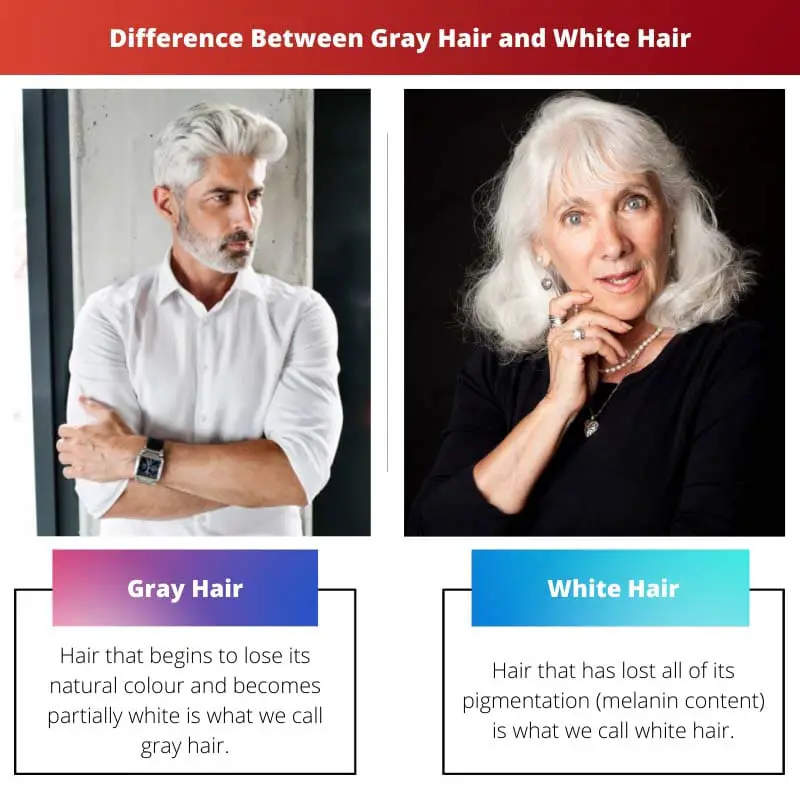The greying of hair is as natural a process as the ageing of the human body. Other than old age, certain illnesses can trigger your hair to turn grey.
A chemical called melanin gives your hair its natural colour. Pheomelanin produces red and blonde colours.
Eumelanin gives your hair the darker colours of black and brown. A decrease in the melanin levels produced by the pigment cells under your scalp causes your hair to lose its natural colour.
Key Takeaways
- Gray hair results from a mixture of pigmented and unpigmented (white) strands, occurring as hair loses its natural pigment over time.
- White hair is devoid of pigment, resulting from the complete loss of melanin in the hair strands.
- Both gray hair and white hair are associated with aging, but gray hair is a mixture of pigmented and unpigmented strands, while white hair has lost all pigment.
Gray Hair vs White Hair
The difference between Gray Hair and White Hair is that the former results from the natural loss of your hair’s original colour with age (or due to an illness). You are left with white hair when your hair completely loses its natural pigmentation (melanin).

Grey hair is formed when hair strands still have some melanin content. White hair grows when pigment cells are unable to produce more melanin.
Comparison Table
| Parameter of Comparison | Grey Hair | White Hair |
|---|---|---|
| Description | It is a mixture of white and naturally coloured hair. Hair that begins to lose its natural colour and becomes partially white is called grey hair. | When your hair loses its entire natural colour, it becomes white. Hair that has lost all of its pigmentation (melanin content) is white. |
| Melanin (the chemical that lends our hair its natural colour) | Grey hair is formed at a stage where hair strands still have some melanin content left in them. | White hair grows when pigment cells are unable to produce more melanin. Hair strands lose their natural colour entirely. |
| Age of occurrence | People start seeing their hair turn grey in their 40s, mid-30s or, sometimes, even in their mid-20s. Other than a person’s age, certain illnesses trigger one’s hair to lose its natural colour. | It takes 10 years for grey hair to turn completely white. Certain medical conditions (Marie Antoinette syndrome) could quickly trigger hair to turn white. |
| Genetic causes | Genes are a significant determinant in knowing when a person’s hair greys. People with blonde hair have a higher tendency to turn grey. Such is not the case with people with naturally dark hair. | Once it starts to grey, your hair loses its natural colour and eventually turns white. |
| Other causes | As we age, hair loses its natural colour and turns grey. However, vitamin B-12 deficiency, thyroid disease, vitiligo, alopecia areata, neurofibromatosis and tuberous sclerosis are some illnesses that can cause premature greying of hair. Greying of hair is also linked to smoking Tobacco and stress too. | Once it starts to grey (owing to the reasons mentioned in the column to the left), your hair loses its natural colour and eventually turns white. |
What is Gray Hair?
It is a mixture of white and naturally coloured hair. Hair that begins to lose its natural colour and becomes partially white is called grey hair.
The chemical melanin lends your hair its natural colour. Grey hair is formed at a stage where hair strands still have some melanin content left in them.
Primarily, a person’s genes determine when one gets grey hair. However, certain illnesses make this happen at a faster rate.
People start seeing their hair turn grey in their 40s, mid-30s or, sometimes, even in their mid-20s. Vitamin B-12 deficiency, thyroid disease, vitiligo, alopecia areata, neurofibromatosis and tuberous sclerosis are some illnesses that can cause premature greying of hair. Greying of hair is also linked to smoking Tobacco and stress.

What is White Hair?
When your hair loses its entire natural colour, it becomes white. Hair that has lost all of its pigmentation (melanin content) is white.
White hair grows when pigment cells are unable to produce more melanin. Hair strands lose their natural colour entirely.
It takes 10 years for grey hair to turn completely white. Certain medical conditions (Marie Antoinette syndrome) could quickly trigger hair to turn white.
Once it becomes grey, your hair loses its natural colour and eventually turns white.

Main Differences Between Gray Hair and White Hair
- We call grey hair a mixture of white and naturally coloured hair. Hair that has lost all of its pigmentation (melanin content) is white.
- Grey hairs still have some melanin left in them. White hair grows when pigment cells are unable to produce more melanin. White hair strands have entirely lost their natural colour.
- Your genetics are the primary determinant of when you’re hair starts to grey. Certain illnesses trigger premature greying of hair. Hair eventually loses its full colour and becomes white.
- Usually, people in their 40s or mid-30s notice grey strands on their heads for the first time. Sometimes, one’s hair starts greying in his/her mid-20s. It takes 10 years for grey hair to turn completely white.
- B-12 deficiency, thyroid disease, vitiligo, and alopecia areata are some illnesses that can cause premature greying of hair. Hair eventually loses its full colour and becomes white.

- https://jamanetwork.com/journals/jamadermatology/article-abstract/547429
- https://www.amjmed.com/article/0002-9343(71)90232-4/pdf

The article offers a comprehensive comparison between gray and white hair and delves into the scientific and genetic factors affecting these hair pigmentation changes. It’s a valuable source of knowledge.
Absolutely, Nmorris. The article provides detailed insights into the causes and effects of gray and white hair, reflecting extensive research.
I agree, Nmorris. The article effectively discusses premature greying caused by certain medical conditions and its association with aging.
This article brings light to the natural processes of hair pigmentation changes with age and provides a thorough understanding of gray and white hair. It’s quite an eye-opening read.
Absolutely, Lindsay45. The article effectively explains how melanin levels impact the color changes in hair.
I found the comparison table extremely helpful in distinguishing between gray and white hair. It’s a well-structured piece of information.
This article on gray and white hair is quite informative and gives a great understanding of the science behind this natural process. The comparison table is helpful in understanding the key differences between grey and white hair.
I completely agree, Umiller. The detailed explanation of how melanin affects the color of our hair is quite enlightening.
I’m glad to see a well-researched article that covers the topic of gray vs. white hair in such depth. It’s quite interesting to learn about the genetic, age-related, and illness-related factors that contribute to this natural process.
The article offers a scientifically accurate comparison between gray and white hair, along with the underlying genetic and age-related factors. It’s certainly an enlightening read.
I concur, Murphy Zach. The article provides readers with a clear understanding of the processes involved in hair greying and whitening.
The article covers the scientific and medical aspects of gray and white hair comprehensively. It’s evident that thorough research has been conducted to provide accurate information on this topic.
Agreed, Pellis. The information about the illnesses that contribute to premature greying of hair is particularly valuable.
Indeed, Pellis. The article effectively explains the role of melanin in hair pigmentation and how it relates to the graying and whitening of hair.
The article provides a clear distinction between gray and white hair, offering scientific details along with the age and genetic factors that influence this process. It’s definitely an insightful read.
Yes, Ubaker, the comparison table is particularly useful in summarizing the differences between gray and white hair. The genetic causes section is quite intriguing.
The detailed comparison between gray and white hair in this article provides readers with a comprehensive understanding of these natural processes. It’s a well-structured and intellectually enriching piece of content.
I completely agree, Vmurphy. The article effectively addresses the underlying causes of gray and white hair, delving into the scientific and age-related factors.
The article’s detailed descriptions and comparison of gray and white hair are quite informative. It sheds light on the correlation between melanin levels and the natural aging process.
I found the article to be highly educational and well-researched. The insights into the genetic causes of hair pigmentation changes are particularly thought-provoking.
Absolutely, Nwalker. The article effectively explores the reasons behind premature greying and whitening of hair, making it a valuable read.
The detailed explanations about gray and white hair in this article are quite illuminating. The correlation between hair pigmentation and age-related factors is well articulated.